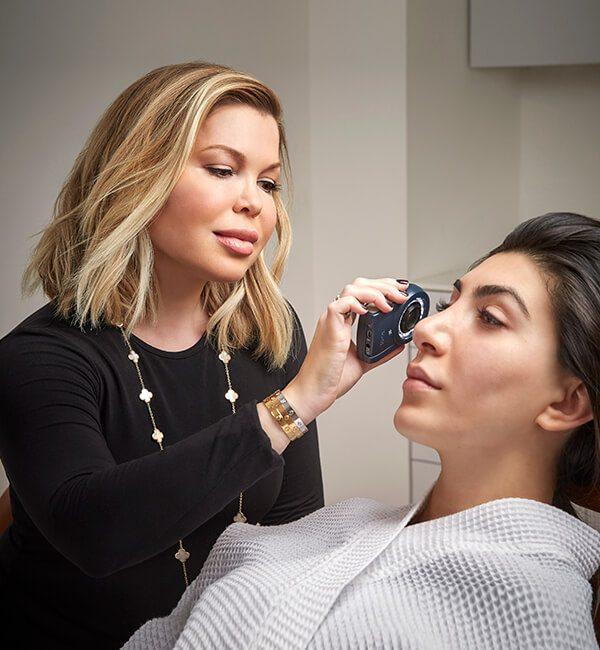- Dermatology
- Plastic Surgery
- Ariel N. Rad, M.D., PH.D.
- Face Cosmetic Surgery
- Breast Cosmetic Surgery
- Body Contouring
- Breast Cancer Reconstruction
- Destination & Travel Package
- Gallery
- Testimonials
- Boutique
- PRESS + BLOG



Abnormal skin pigmentation and discoloration can have many causes. Finding the root cause is the key to restoring even skin tone and pigmentation.
Sun Damage can take many forms in the skin, from pre-cancers to dark spots to redness and visible veins to enlarged pores. Dr. Sherber’s approach centers on enhancing your skin’s reparative mechanisms through advanced skincare products that are packed with retinoids, glycolic acids and antioxidants, fractionated non-ablative Lasers, and skin cancer prevention.
Melasma can be triggered by hormonal shifts, certain topical treatments and incorrectly delivered laser treatments. Dr. Sherber often sees patients for second opinion because their melasma worsened from previous mismanagement. Dr. Sherber helps her patients navigate their way to healthy, even skin. Explore Melasma to learn more.
We all feel tired at times but we don’t have to look it. Dark circles under the eyes can be improved with targeted treatments ranging from Lasers to Injectable Dermal Filler. Explore Dark Circles to learn more.
Dark spots can be anything from freckles to skin cancer. Dr. Sherber first determines what the dark spots are, and then she customizes treatment. Explore Dark Spots to learn more.

Sun damage can take many forms in the skin, from pre-cancers to dark spots to redness and visible veins to enlarged pores.
UV exposure generates free radicals in the skin which damage collagen and DNA and, in turn, contribute to skin aging and *skin cancer*.
The good news about sun damage is that the skin has powerful methods of repair, and topical products can enhance both collagen synthesis and DNA repair.
RECOMMENDED TREATMENTS
Skincare products with clinically active concentrations of retinoids, glycolic acids, and antioxidants can enhance skin’s reparative mechanisms.
Fractionated non-ablative lasers such as *Clear+Brilliant* are clinically proven to reduce pre-cancerous damage by by bringing fresh undamaged skin to the surface.
For those with clinically evident sun damage, Dr. Sherber recommends an annual total body skin examination for *skin cancer* surveillance and monthly self-administered skin exams at home to check for new or changing spots.
OTHER OPTIONS
Chemical peels such as the antioxidant-enriched glycolic Vivité peel assist in bringing fresh skin to the surface and eradicating damage.
If Dr. Sherber detects any pre-cancers, these may need to be treated with prescription creams that selectively remove abnormal cells.
Melasma is characterized by homogenous areas of dark pigmentation that most commonly appear on areas of the face such as the forehead, upper lip, and cheeks.
Melasma can be triggered by hormonal changes of pregnancy, or from exogenous hormones such as birth control pills or hormone supplements.
Melasma can be worsened by certain topical treatments and laser treatments, so expertise is key in successful management.
RECOMMENDED TREATMENTS
Daily broad spectrum sun protection is essential to the treatment of melasma. Mineral sunscreens are best since even visible light can worsen melasma.
Topical brighteners can help to fade unwanted pigmentation, but must be carefully chosen so as not to trigger additional pigmentation caused by inflammation of the skin.
The most data-driven approach to treating melasma is with the new Clear+Brilliant Perméa laser. The 1927nm wavelength is very effective at targeting the darker areas of pigmentation without inflaming the skin. Dr. Sherber uses the opportunity immediately post-laser, when absorption of topical treatments is increased 17x, to apply a customized blend of brightening serums to each patient’s skin for added benefit.
Depending on the depth and severity of melasma, Dr. Sherber may pre-treat the skin for several weeks prior to laser treatment using a tailored regimen of topical treatments.
OTHER OPTIONS
Dr. Sherber may recommend labs to check for hormonal irregularities ranging from estrogen hormones to thyroid imbalances.
If melasma is triggered by oral contraceptives, Dr. Sherber may recommend changes to your medication regimen.
Dr. Sherber does not recommend IPL in the treatment of melasma since for most skin types it can result in initial improvement and subsequent worsening of pigmentation.
Eyelids have the thinnest skin on the human body, and can show the first signs of aging.
Some people have a genetic tendency for darkness or shadowing under the eyes that isn’t age-related.
The key distinction is whether the “dark circle” is due to brown discoloration of the skin, veins showing through the surface of the skin and causing a blue hue, or a true shadow from hollowing under the eyes.
RECOMMENDED TREATMENTS
For brown discoloration under the eyes, Dr. Sherber will customize a regimen of topical brightening treatments, and may recommend Perméa laser treatments for more intensive brightening.
For visible veins, a very gentle treatment with the Nd:YAG laser can fade the bluish hue under the eyes.
Skincare products can make a significant difference in the appearance of “dark circles.” Supersaturating the under eye area with hydrating eye creams can product notable plumping, whereas application of caffeine-containing products can depuff.
Hollowing under the eyes can be improved with injectable dermal fillers to soften the shadows. Since the filler is placed deep above the orbital bone and therefore doesn’t get worn down by strong muscle contractions as it does in other sites, it generally lasts for months to years.
OTHER OPTIONS
For those with significantly sunken or protruding under eye contour, a lower blepharoplasty may be the best choice to produce the most natural-looking result as opposed to the addition of volume with fillers.
Crepey skin in the under eye area can be made more dense with fractionated non-ablative laser treatments such as Clear+Brilliant and a combination of Perméa and targeted topical treatments.
Uneven skin tone can develop from genetics, environmental damage, or a combination of both.
Dark spots which darken significantly following sun exposure may be freckles, or ephiledes. Dark spots which are always present and appeared after childhood are generally sun spots, or solar lentigines.
Dr. Sherber examines all dark spots for signs of abnormality before embarking on cosmetic treatment. Dark spots that are new or changing, or that don’t meet the ABCDE criteria may be concerning for skin cancer.
RECOMMENDED TREATMENTS
Topical treatments with brightening ingredients or glycolic acid can fade unwanted pigmentation when paired with rigorous use of broad spectrum sun protection.
Laser treatments are often the best way to break up uneven pigmentation and produce rapid and reliable results. The Perméa laser fades dark spots without social downtime, while the LimeLight spot-treats areas of stubborn pigmentation.
LimeLight is generally a winter sport since skin should not be tanned pre- or post-treatment, whereas Perméa is safe even in the summer months.
OTHER OPTIONS
Chemical peels such as the Vivité can be a valuable addition to a skincare regimen geared towards fading unwanted pigmentation.
When dark spots are intermixed with red areas, Laser Genesis can helpful evening out the complexion by fading both brown and red areas.



Dr. Sherber graduated magna cum laude from Harvard University, where she designed and implemented a novel degree program in health policy focused on assessing and improving quality of care. She next attended the Johns Hopkins University School of Medicine where she earned her M.D. degree. Following a post-doctoral fellowship in clinical research at Columbia University, she returned to Johns Hopkins for dermatology residency training and conducted research in scar healing and in disorders of abnormal collagen. She is now a Clinical Assistant Professor at George Washington University in the Department of Dermatology.
We look forward to welcoming you for your private consultation
Enjoy a unique experience centered on your privacy and on unhurried attention to your concerns
Or Send a confidential inquiry and our staff will be happy to reach out to you
Sherber+Rad1101 15th St. NW, Suite 100, Washington, D.C. 20005